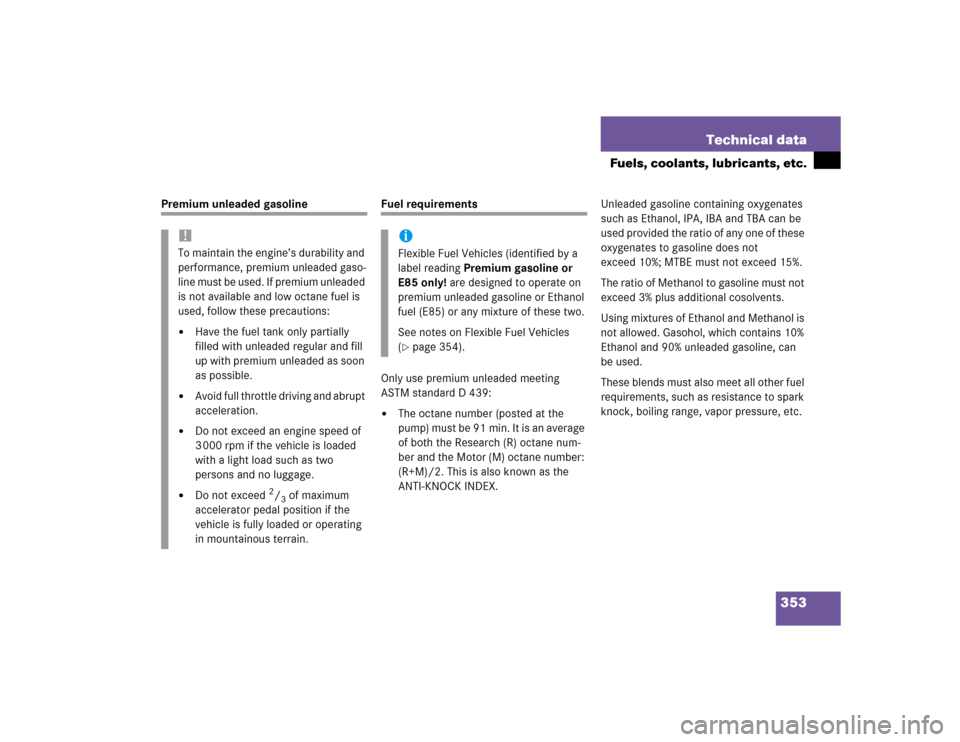Page 251 of 400

251 Operation
At the gas station
Check regularly and before a long trip
1Coolant level
For more information on coolant, see
“Coolant level” (
�page 257).
2Brake fluid (fuse box cover removed)
Removing fuse box cover
(
�page 333).
3Windshield washer and headlamp
cleaning system*
For more information on filling up the
washer reservoir, see “Windshield
washer system and headlamp cleaning
system*” (
�page 259).Engine oil level
For more information on engine oil level,
see “Engine oil” (
�page 253).
Opening hood (
�page 252).
Vehicle lighting
Check function and cleanliness. For more
information on replacing light bulbs, see
“Replacing bulbs” (�page 310).
Exterior lamp switch (�page 102).
Tire inflation pressure
More information on tire inflation pressure
(
�page 261).
!If you find that the brake fluid in the
brake fluid reservoir has fallen to the
minimum mark or below, have the
brake system checked for brake pad
thickness and leaks immediately.
Notify an authorized Mercedes-Benz
Center immediately. Do not add brake
fluid as this will not solve the problem.
For more information, see “Practical
hints” (
�page 275).
Page 261 of 400

261 Operation
Tires and wheels
Life of tire
The service life of a tire is dependent upon
varying factors including but not limited to:�
Driving style
�
Tire pressure
�
Distance driven
Direction of rotation
Unidirectional tires offer added advan-
tages, such as better hydroplaning perfor-
mance. To benefit, however, you must
make sure the tires rotate in the direction
specified.
An arrow on the sidewall indicates the
intended direction of tire rotation.Checking tire inflation pressure
Correct the tire pressure only when tires
are cold.
Regularly check your tire pressure at
intervals of no more than 14 days. If the tires are warm you should only
correct the tire pressure if it is too low for
current operating conditions.
A table on the fuel filler flap lists the
specified tire inflation pressures for warm
and cold tires as well as for various
operating conditions.
Warning!
G
Tires and spare tire should be replaced after
six years, regardless of the remaining tread.!Keep unmounted tires in a cool, dry
place with as little exposure to light as
possible. Protect tires from contact
with oil, grease and gasoline.
Warning!
G
If the tire pressure drops repeatedly:�
Check the tires for punctures from
foreign objects.
�
Check to see whether air is leaking from
the valves or from around the rim.
iThe pressures listed for light loads are
minimum values offering high driving
comfort.
Increased inflation pressures listed for
heavier loads may also be used for light
loads. These higher pressures produce
favorable handling characteristics. The
ride of the vehicle, however, will be
somewhat harder. Never exceed the
max. values or inflate tires below the
min. values listed in the fuel filler flap.
Page 353 of 400

353 Technical data
Fuels, coolants, lubricants, etc.
Premium unleaded gasoline
Fuel requirements
Only use premium unleaded meeting
ASTM standard D 439:�
The octane number (posted at the
p um p) m us t be 91 mi n. It i s an a vera ge
of both the Research (R) octane num-
ber and the Motor (M) octane number:
(R+M)/2. This is also known as the
ANTI-KNOCK INDEX.Unleaded gasoline containing oxygenates
such as Ethanol, IPA, IBA and TBA can be
used provided the ratio of any one of these
oxygenates to gasoline does not
exceed 10%; MTBE must not exceed 15%.
The ratio of Methanol to gasoline must not
exceed 3% plus additional cosolvents.
Using mixtures of Ethanol and Methanol is
not allowed. Gasohol, which contains 10%
Ethanol and 90% unleaded gasoline, can
be used.
These blends must also meet all other fuel
requirements, such as resistance to spark
knock, boiling range, vapor pressure, etc.
!To maintain the engine’s durability and
performance, premium unleaded gaso-
l i n e m u s t b e u s e d . I f p r e m i u m u n l e a d e d
is not available and low octane fuel is
used, follow these precautions:�
Have the fuel tank only partially
filled with unleaded regular and fill
up with premium unleaded as soon
as possible.
�
Avoid full throttle driving and abrupt
acceleration.
�
Do not exceed an engine speed of
3 000 rpm if the vehicle is loaded
with a light load such as two
persons and no luggage.
�
Do not exceed
2/3 of maximum
accelerator pedal position if the
vehicle is fully loaded or operating
in mountainous terrain.
iFlexible Fuel Vehicles (identified by a
label reading Premium gasoline or
E85 only! are designed to operate on
premium unleaded gasoline or Ethanol
fuel (E85) or any mixture of these two.
See notes on Flexible Fuel Vehicles
(�page 354).
Page 372 of 400

372 IndexCenter console 25
Lower part 26
PASS. AIRBAG OFF
indicator lamp 279
Upper part 25
Centigrade
Setting temperature units 127
Central locking
Automatic 90
From inside 91
Switch 91
Switching on/off
(control system) 133
Unlocking from inside 91
Central locking switch 91
Certification label 338
Changing
Batteries (SmartKey) 307
CDs 189
Key setting 133
Charcoal filter 169Charging
Vehicle battery 324
CHECK ENGINE
malfunction indicator lamp 276
Checking
Brake fluid 251
Coolant level 251, 257
Engine oil level 251, 254
Tire inflation pressure 251
Vehicle lighting 251
Child safety 63
Airbags 56
Infant and child restraint
systems 60, 63
LATCH-type child seat anchors 69
Child safety switch see
Blocking of rear door window operation
Child seat anchors
see LATCH-type child seat anchors
Cigarette lighter 221Cleaning
Cloth upholstery 272
Cup holder 271
Gear selector lever 271
Hard plastic trim items 271
Headlamps 148
Headliner and shelf below
rear window 271
Instrument cluster 270
Leather upholstery 271
Light alloy wheels 270
MB Tex upholstery 272
Plastic and rubber parts 272
Seat belts 271
Steering wheel 271
Upholstery 271
Windows 270
Windshield 48
Wiper blades 270
Wood trims 272